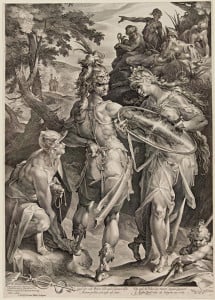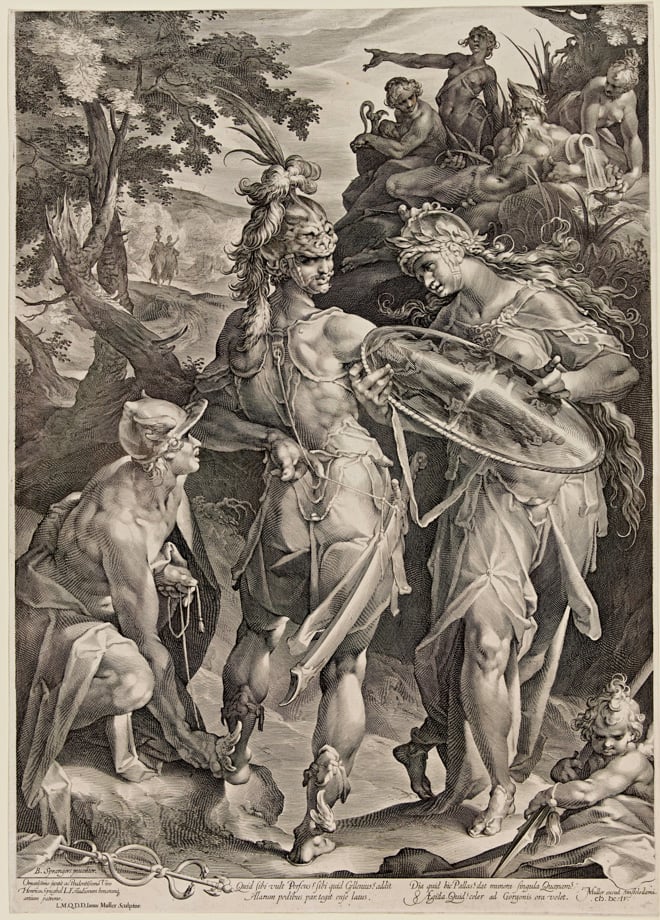
“Myth, Allegory and Faith” traces the rise of Mannerism, the dominant artistic style in 16th century Europe. Mannerist art usually takes the form of engravings, etchings, woodcuts and chiaroscuro woodcuts, often sporting religious and historical undertones. Mannerism first disseminated from Renaissance Florence and Rome – a hub for masters of illustration and figuration – to France, the Holy Roman Empire and other European cultural hubs. Consequently, many of the figurative works on display combine small scale with painstakingly intricate detail.
Michelangelo played a key role in the growth of the Mannerist movement, as his work was an exposé of the dynamism and beauty of the human figure. Indeed, Italian and Dutch artists like Battista Franco and Jan Saenredam sought to utilize the figure as a mode of storytelling. The traces of Michelangelo’s influence in Mannerist artists’ work are hardly subtle: Powerful, ideally proportioned figures populate and contort themselves across the walls of Cantor’s Pigott Gallery. In Jan Saendram’s “The Punishment of Niobe,” for example, Saendram completely fills his drawing surface with precisely detailed figures, inviting viewers to lose themselves in the countless overlapping shapes and dynamic lines of action.
A commonality across mannerist works is the use of the human figure as a compositional element. Poses flow into each other, siphoning the eye across the page. Mannerist figures are rarely ever stagnant; rather, the artists utilize “contrapposto,” an Italian term signifying a contortion or counterpose, to create the illusion of movement. In Agostino Musi’s “The Carcass,” the artist frames the figures in the piece with a spiraling, gnarled skeleton of a four-legged creature, which mirrors the arched backs of the figures in the piece.
The Mannerist works on display are distinguished by their immersive narrative quality, particularly Cornelis Cort’s comic book-esque series of ten prints portraying the allegory of Hercules. Cort employs the figure as storytelling, depicting Hercules as an intensely muscled nude figure. Hercules is always shown in action through candid motion shots. Here, Cort demonstrates the Mannerist affinity for action and movement. In “Hercules Chains Cerberus,” the outline of Hercules’ outstretched, club-wielding arms creates a sharp diagonal line that cuts across the center of the piece, creating a sense of explosive vigor.
When working with larger canvases, Mannerist artists often chose to populate the piece with even more figures, as opposed to simply scaling up the figures. French artist Antonio Fantuzzi, in a pair of works entitled “The Clemency of Scipio” and “The Banquet of Scipio,” portrays large-scale scenes that are claustrophobic, chaotic and visually stunning. In both pieces, Fantuzzi uses sheer quantity of bodies to suggest violence and dehumanization – amongst such a large crowd, the characters lose their individuality and degenerate into shapes and patterns.
“Myth, Allegory and Faith” focuses on Mannerism as storytelling and the human figure as a design element. The artists convey their characters’ emotions not just through facial expressions, but through body language and dynamic interplay of shapes. Paying homage to an age of obsessive perfectionism and pin-sharp detail, “Myth, Allegory and Faith” immerses viewers in a world of fantastical settings and meticulously rendered heroes.
“Myth, Allegory and Faith” is on view at the Cantor Arts Center until June 20, 2016.
Contact Eric Huang at [email protected].
